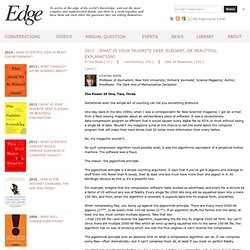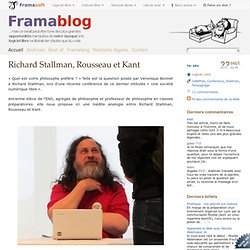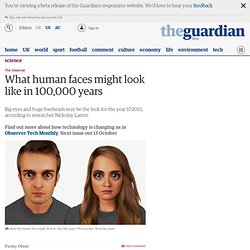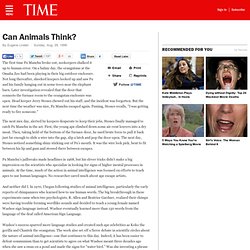

Les ernest. Au service des valeurs du soin. Edge.org. The Power Of One, Two, Three Sometimes even the simple act of counting can tell you something profound.

One day, back in the late 1990s, when I was a correspondent for New Scientist magazine, I got an e-mail from a flack waxing rhapsodic about an extraordinary piece of software. It was a revolutionary data-compression program so efficient that it would squash every digital file by 95% or more without losing a single bit of data. Wouldn't my magazine jump at the chance to tell the world about the computer program that will make their hard drives hold 20 times more information than every before.
No, my magazine wouldn't. No such compression algorithm could possibly exist; it was the algorithmic equivalent of a perpetual motion machine. The reason: the pigeonhole principle. How Intelligent is Artificial Intelligence? - Computerphile. Podcast Science. Saxophone quartets and probability › Heidelberg Laureate Forum. Saxophone quartets consist of four saxophones, usually a baritone, tenor, alto, and soprano, or maybe a second alto instead of a soprano.

Because all saxophones are essentially the same instrument, just at different sizes, the instruments blend remarkably well. Saxophone quartets are not common, and yet I've run into two in two days. I arrived in Heidelberg on Saturday to have some time to walk around and get over my jet lag before the Heidelberg Laureate Forum (HLF) events started. While I was walking around I ran into the all-female sax quartet Femdüsax performing in an outdoor plaza. FemdüsaxImage: John D. Then the next day, there was another saxophone quartet performing at the opening ceremony for HLF. Balanced ActionImage: John D. What's the probability of seeing two all-female saxophone quartets in the same area on two consecutive days? Richard Stallman, Rousseau et Kant. « Quel est votre philosophe préféré ?

» Telle est la question posée par Véronique Bonnet à Richard Stallman, lors d’une récente conférence de ce dernier intitulée « Une société numérique libre ». Ancienne élève de l’ENS, agrégée de philosophie et professeur de philosophie en classes préparatoires. elle nous propose ici une inédite analogie entre Richard Stallman, Rousseau et Kant. Richard Stallman, Rousseau et Kant. Une lecture de sa conférence du 20 septembre à Télécom Paris Tech, par Véronique Bonnet. Programmer un robot industriel avec le langage.
Plus vite que la lumière. What human faces might look like in 100,000 years. Since we humans are prone to launching chemical weapons, unwittingly killing off the bee population or other factors that could lead to our extinction, it may be presumptuous to imagine what we'll look like in 100,000 years.

But designer and researcher Nickolay Lamm has speculated anyway, concluding with some rather startling illustrations that suggest that we'll look a bit like the aliens in Close Encounters of the Third Kind: large, bug eyes, huge foreheads and pigmented skin. It's conjecture, but also more than armchair futurism. Lamm based his illustrations on discussions with Dr Alan Kwan, an expert in computational genomics from Washington University who drew up a research paper to guide Lamm's artwork.
Changes in the air and light around us will lead to adjustments in our facial structure, but we'll also be able to change what facial features we're born with, based on what's genetically trendy at the time. Parmy Olson is a technology writer for Forbes magazine in San Francisco. Can Animals Think? The first time Fu Manchu broke out, zookeepers chalked it up to human error.

On a balmy day, the orangutans at the Omaha Zoo had been playing in their big outdoor enclosure. Not long thereafter, shocked keepers looked up and saw Fu and his family hanging out in some trees near the elephant barn. Later investigation revealed that the door that connects the furnace room to the orangutan enclosure was open. Head keeper Jerry Stones chewed out his staff, and the incident was forgotten. But the next time the weather was nice, Fu Manchu escaped again. Les animaux pensent-ils ?
Frans de Waal : Le comportement moral des animaux. Les petits animaux verraient le monde au ralenti. Des chercheurs irlandais et écossais ont établi, à partir des travaux réalisés par plusieurs autres équipes de biologistes, que les petits animaux peuvent capter davantage d'informations visuelles et la traiter plus rapidement que les gros.

Des scientifiques du Trinity College de Dublin (TCD, Irlande) et de l'Université de St Andrews (Écosse) ont compilé et traduit graphiquement des données (issues de recherches antérieures) portant sur la vitesse à laquelle l'œil de divers animaux peut traiter la lumière (et donc l’information visuelle). THE NORMAL WELL-TEMPERED MIND. I'm trying to undo a mistake I made some years ago, and rethink the idea that the way to understand the mind is to take it apart into simpler minds and then take those apart into still simpler minds until you get down to minds that can be replaced by a machine.

This is called homuncular functionalism, because you take the whole person. You break the whole person down into two or three or four or seven sub persons that are basically agents.